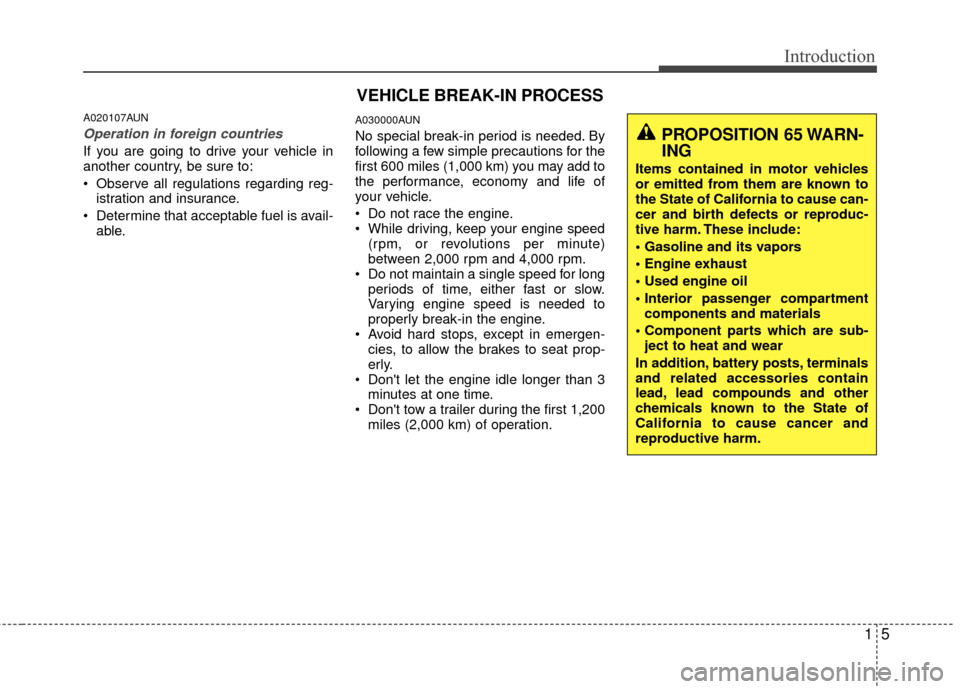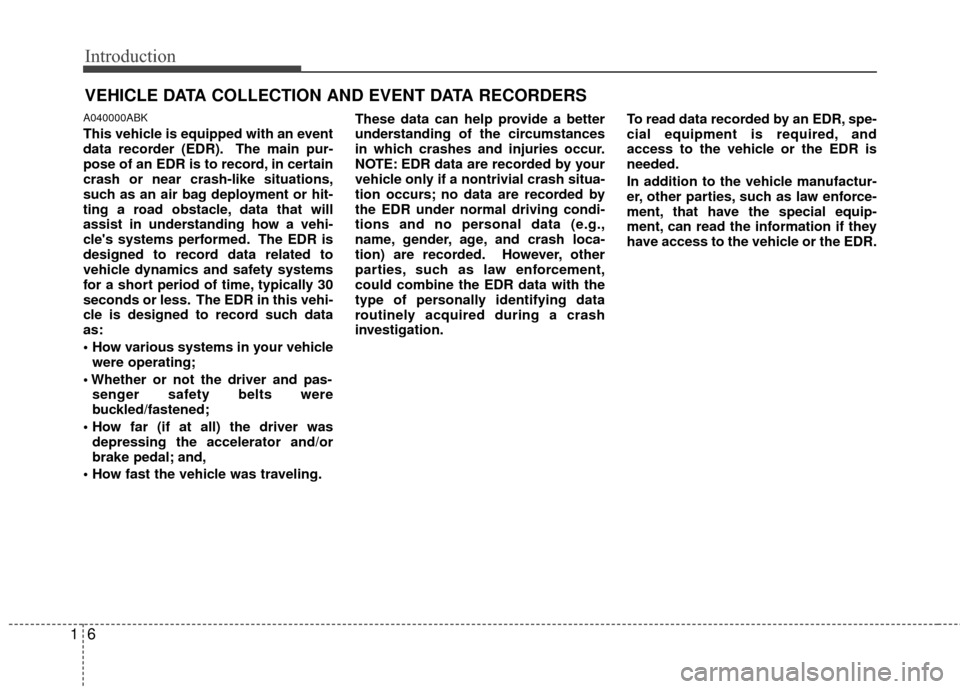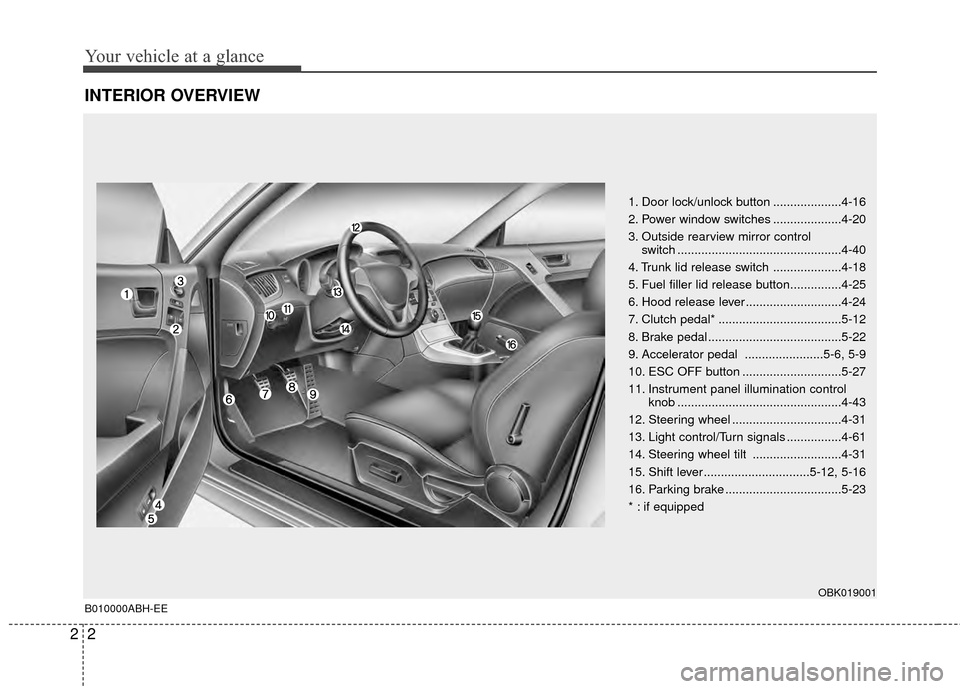Page 12 of 391

15
Introduction
A020107AUN
Operation in foreign countries
If you are going to drive your vehicle in
another country, be sure to:
Observe all regulations regarding reg-istration and insurance.
Determine that acceptable fuel is avail- able.
A030000AUN
No special break-in period is needed. By
following a few simple precautions for the
first 600 miles (1,000 km) you may add to
the performance, economy and life of
your vehicle.
Do not race the engine.
While driving, keep your engine speed(rpm, or revolutions per minute)
between 2,000 rpm and 4,000 rpm.
Do not maintain a single speed for long periods of time, either fast or slow.
Varying engine speed is needed to
properly break-in the engine.
Avoid hard stops, except in emergen- cies, to allow the brakes to seat prop-
erly.
Don't let the engine idle longer than 3 minutes at one time.
Don't tow a trailer during the first 1,200 miles (2,000 km) of operation.PROPOSITION 65 WARN-
ING
Items contained in motor vehicles
or emitted from them are known to
the State of California to cause can-
cer and birth defects or reproduc-
tive harm. These include:
components and materials
ject to heat and wear
In addition, battery posts, terminals
and related accessories contain
lead, lead compounds and other
chemicals known to the State of
California to cause cancer and
reproductive harm.
VEHICLE BREAK-IN PROCESS
Page 13 of 391

Introduction
61
A040000ABK
This vehicle is equipped with an event
data recorder (EDR). The main pur-
pose of an EDR is to record, in certain
crash or near crash-like situations,
such as an air bag deployment or hit-
ting a road obstacle, data that will
assist in understanding how a vehi-
cle's systems performed. The EDR is
designed to record data related to
vehicle dynamics and safety systems
for a short period of time, typically 30
seconds or less. The EDR in this vehi-
cle is designed to record such data
as:
were operating;
senger safety belts were
buckled/fastened;
depressing the accelerator and/or
brake pedal; and,
These data can help provide a better
understanding of the circumstances
in which crashes and injuries occur.
NOTE: EDR data are recorded by your
vehicle only if a nontrivial crash situa-
tion occurs; no data are recorded by
the EDR under normal driving condi-
tions and no personal data (e.g.,
name, gender, age, and crash loca-
tion) are recorded. However, other
parties, such as law enforcement,
could combine the EDR data with the
type of personally identifying data
routinely acquired during a crash
investigation.
To read data recorded by an EDR, spe-
cial equipment is required, and
access to the vehicle or the EDR is
needed.
In addition to the vehicle manufactur-
er, other parties, such as law enforce-
ment, that have the special equip-
ment, can read the information if they
have access to the vehicle or the EDR.
VEHICLE DATA COLLECTION AND EVENT DATA RECORDERS
Page 14 of 391
17
Introduction
INDICATOR SYMBOLS ON THE INSTRUMENT CLUSTER
Seat belt warning light
High beam indicator
Turn signal indicator
ABS warning light
Parking brake & Brake fluid warning light
Engine oil pressure warning light
Malfunction indicator light
Air bag warning light
Cruise indicator (if equipped)
Cruise SET indicator (if equipped)
Immobilizer indicator
Low fuel level warning light
* For more detailed explanations, refer to “Instrument cluster” in section 4.
Charging system warning light
Low windshield washer fluid level warning light
(if equipped)
A050000ABK-EU
Door ajar warning light
Trunk ajar warning light
Front fog light indicator (if equipped)
TPMS (Tire Pressure Monitoring System) malfunction
indicator (if equipped)
Low tire pressure telltale (if equipped)
ESC indicator
ESC OFF indicator
Key out warning (if equipped)
KEY
OUT
Page 16 of 391

Your vehicle at a glance
22
INTERIOR OVERVIEW
1. Door lock/unlock button ....................4-16
2. Power window switches ....................4-20
3. Outside rearview mirror control switch ................................................4-40
4. Trunk lid release switch ....................4-18
5. Fuel filler lid release button...............4-25
6. Hood release lever ............................4-24
7. Clutch pedal* ....................................5-12
8. Brake pedal .......................................5-22
9. Accelerator pedal .......................5-6, 5-9
10. ESC OFF button .............................5-27
11. Instrument panel illumination control knob ................................................4-43
12. Steering wheel ................................4-31
13. Light control/Turn signals ................4-61
14. Steering wheel tilt ..........................4-31
15. Shift lever ...............................5-12, 5-16
16. Parking brake ..................................5-23
* : if equipped
OBK019001
B010000ABH-EE
Page 18 of 391
Your vehicle at a glance
42
ENGINE COMPARTMENT
1. Negative battery terminal..................7-30
2. Positive battery terminal ...................7-30
3. Fuse and relay box ...........................7-47
4. Windshield washer fluid reservoir .....7-22
5. Power steering fluid reservoir ...........7-21
6. Air cleaner.........................................7-24
7. Radiator cap .....................................7-19
8. Engine oil filler cap ...........................7-16
9. Engine oil dipstick .............................7-16
10. Brake & clutch fluid reservoir ..........7-20
11. Engine coolant reservoir .................7-18
OBK019003B030000ABH-EE
■
■2.0 TCI Engine
* The actual engine compartment in the vehicle may differ from the illustration.
Page 19 of 391
25
Your vehicle at a glance
1. Negative battery terminal..................7-30
2. Positive battery terminal ...................7-30
3. Fuse and relay box ...........................7-47
4. Windshield washer fluid reservoir .....7-22
5. Power steering fluid reservoir ...........7-21
6. Air cleaner.........................................7-24
7. Radiator cap .....................................7-19
8. Engine oil dipstick .............................7-16
9. Engine oil filler cap ...........................7-16
10. Brake & clutch fluid reservoir ..........7-20
11. Engine coolant reservoir .................7-18
■ ■
3.8 Engine
* The actual engine compartment in the vehicle may differ from the illustration.
OBK019004
Page 32 of 391

313
Safety features of your vehicle
WARNING
When you return the rear seatback
to its upright position after being
folded down:
Be careful not to damage the seat
belt webbing or buckle. Do not
allow the seat belt webbing or
buckle to get caught or pinched in
the rear seat. Ensure that the seat-
back is completely locked into its
upright position by pushing on the
top of the seatback. Otherwise, in
an accident or sudden stop, the
seat could fold down and allow
cargo to enter the passenger com-
partment, which could result in
serious injury or death.
CAUTION- Rear seat belts
When returning the rear seatbacksto the upright position, rememberto return the rear shoulder belt toits proper position.
After returning the rear seatbacks to the upright position, check thatthe rear seats are secure.WARNING- Cargo
Cargo should always be secured to
prevent it from being thrown about
the vehicle in a collision and caus-
ing injury to the vehicle occupants.
Do not place objects on the rear
seats, since they cannot be proper-
ly secured and may hit the front
seat occupants in a collision.
WARNING - Cargo loading
Make sure the engine is off, the
automatic transaxle is in P (Park) or
the manual transaxle is in reverse,
and the parking brake is securely
applied whenever loading or
unloading cargo. Failure to take
these steps may allow the vehicle
to move if the shift lever is inadver-
tently moved to another position.
Page 93 of 391

Features of your vehicle
16
4
✽
✽
NOTICE
• In cold and wet climates, door locks
and door mechanisms may not work
properly due to freezing conditions.
• If the door is locked/unlocked multi- ple times in rapid succession with
either the vehicle key or door lock
switch, the system may stop operating
temporarily in order to protect the
circuit and prevent damage to system
components.
• If you open the door when the window is closed completely, the window will
go down slightly. If you close the door
when the window is closed completely,
the window will go up slightly.
It is to reduce the airflow noise and
prevent water leakage by closing the
door completely. Mechanical noise
may be heard when you close and
open the door, but this condition is
normal.
To lock a door without the key, push the
inside door lock button (1) or central
door lock switch (2 ) to the “Lock” posi-
tion and close the door (3).
If you lock the door with the central door lock switch (2), all vehicle doors
will lock automatically.
✽ ✽ NOTICE
Always remove the ignition key, firmly
engage the parking brake, close all win-
dows and lock all doors when leaving
your vehicle unattended.
Operating door locks from inside
the vehicle
D050201BBH-EE
With the door lock button
To unlock a door, push the door lock
button (1) to the “Unlock” position. The
red mark (2) on the door lock button
will be visible.
To lock a door, push the door lock but- ton (1) to the “Lock” position. If the door
is locked properly, the red mark (2) on
the door lock button will not be visible.
To open a door, pull the door handle (3) outward.
If the inner door handle of the driver’s (or front passenger’s) door is pulled
when the door lock button is in lock
position, the button is unlocked and
door opens.
OBK049005
Lock Unlock
OBK049004
WARNING
If you don't close the doorsecurely, the door may open
again.
Be careful that someone's body and hands are not trapped when
closing the door.